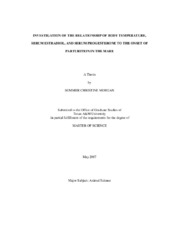| dc.contributor.advisor | Vogelsang, Martha M. | |
| dc.creator | Morgan, Sommer Christine | |
| dc.date.accessioned | 2010-01-15T00:01:29Z | |
| dc.date.accessioned | 2010-01-16T01:27:24Z | |
| dc.date.available | 2010-01-15T00:01:29Z | |
| dc.date.available | 2010-01-16T01:27:24Z | |
| dc.date.created | 2007-05 | |
| dc.date.issued | 2009-05-15 | |
| dc.identifier.uri | https://hdl.handle.net/1969.1/ETD-TAMU-1231 | |
| dc.description.abstract | In cattle and sheep, a significant decrease in temperature has been noted prior to
parturition. In the mare, similar temperature decreases have been documented, although
results have been inconsistent when temperatures were taken rectally. One study
reported a significant temperature decrease when using data from a radio transmitter
inserted into the mare’s flank. The current study utilized nineteen Quarter Horse mares
and one Thoroughbred mare, and was conducted from February to June 2006. Each
mare had been previously implanted in the nuchal ligament with a microchip capable of
reporting body temperatures. Blood collection and temperature recordings began 2 wk
prior to each mare’s expected foaling date. Once the mare was estimated to be within 48
h of parturition, temperature was recorded every 3 h until parturition using both the
microchip and rectal thermometer. Progesterone and estradiol 17-b were evaluated from
daily blood samples from -10 to ± 5 d relative to foaling for determination of the
relationship between these steroids and body temperature, time of foaling, birth weight
and sex of foal. A significant decrease in rectal temperature (P < 0.05) was noted when the last
temperature recorded was taken within 12h of parturition. Microchip data did not
demonstrate any significant differences among readings before parturition. No
significant difference was noted in the mean rectal temperature of all days relative to the
sex of the neonate; however, microchip data showed mares carrying females to have a
significantly (P < 0.05) higher mean rectal temperature of all days. Sex of the foal was
not shown to be related to maternal concentrations of either progesterone or estradiol 17-
b. A direct significant correlation between temperature and maternal plasma
concentrations and progesterone and estradiol 17-b was found. | en |
| dc.format.medium | electronic | en |
| dc.format.mimetype | application/pdf | |
| dc.language.iso | en_US | |
| dc.subject | parturition | en |
| dc.subject | body temperature | en |
| dc.subject | progesterone | en |
| dc.subject | estradiol | en |
| dc.title | Investigation of the relationship of body temperature, serum estradiol, and serum progesterone to the onset of parturition in the mare | en |
| dc.type | Book | en |
| dc.type | Thesis | en |
| thesis.degree.department | Animal Science | en |
| thesis.degree.discipline | Animal Science | en |
| thesis.degree.grantor | Texas A&M University | en |
| thesis.degree.name | Master of Science | en |
| thesis.degree.level | Masters | en |
| dc.contributor.committeeMember | Gibbs, Pete G | |
| dc.contributor.committeeMember | Hinrichs, Katrin | |
| dc.contributor.committeeMember | Scott, Brett D. | |
| dc.type.genre | Electronic Thesis | en |
| dc.type.material | text | en |
| dc.format.digitalOrigin | born digital | en |


